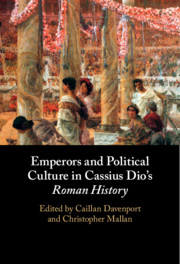63 results
12 - The Court and Ceremonial
-
-
- Book:
- The Roman Emperor and his Court c. 30 BC–c. AD 300
- Published online:
- 29 September 2022
- Print publication:
- 20 October 2022, pp 288-317
-
- Chapter
- Export citation
4 - Rituals and Ceremonial
-
-
- Book:
- The Roman Emperor and his Court c. 30 BC–c. AD 300
- Published online:
- 29 September 2022
- Print publication:
- 20 October 2022, pp 132-183
-
- Chapter
- Export citation
6 - Administration, Finances, and the Court
-
-
- Book:
- The Roman Emperor and his Court c. 30 BC–c. AD 300
- Published online:
- 29 September 2022
- Print publication:
- 20 October 2022, pp 115-145
-
- Chapter
- Export citation
Chapter 8 - War and Peace
- from II - Emperors and Biographies
-
-
- Book:
- Emperors and Political Culture in Cassius Dio's <I>Roman History</I>
- Published online:
- 23 July 2021
- Print publication:
- 12 August 2021, pp 177-196
-
- Chapter
- Export citation
Index
-
- Book:
- Emperors and Political Culture in Cassius Dio's <I>Roman History</I>
- Published online:
- 23 July 2021
- Print publication:
- 12 August 2021, pp 351-358
-
- Chapter
- Export citation
Copyright page
-
- Book:
- Emperors and Political Culture in Cassius Dio's <I>Roman History</I>
- Published online:
- 23 July 2021
- Print publication:
- 12 August 2021, pp iv-iv
-
- Chapter
- Export citation
I - Imperial and Political Narratives
-
- Book:
- Emperors and Political Culture in Cassius Dio's <I>Roman History</I>
- Published online:
- 23 July 2021
- Print publication:
- 12 August 2021, pp 31-112
-
- Chapter
- Export citation
II - Emperors and Biographies
-
- Book:
- Emperors and Political Culture in Cassius Dio's <I>Roman History</I>
- Published online:
- 23 July 2021
- Print publication:
- 12 August 2021, pp 113-196
-
- Chapter
- Export citation
Chapter 2 - News, Rumour, and the Political Culture of the Roman Imperial Monarchy in the Roman History
- from I - Imperial and Political Narratives
-
-
- Book:
- Emperors and Political Culture in Cassius Dio's <I>Roman History</I>
- Published online:
- 23 July 2021
- Print publication:
- 12 August 2021, pp 52-73
-
- Chapter
- Export citation
IV - Reception and Reflection
-
- Book:
- Emperors and Political Culture in Cassius Dio's <I>Roman History</I>
- Published online:
- 23 July 2021
- Print publication:
- 12 August 2021, pp 287-320
-
- Chapter
- Export citation
Introduction - Cassius Dio
-
-
- Book:
- Emperors and Political Culture in Cassius Dio's <I>Roman History</I>
- Published online:
- 23 July 2021
- Print publication:
- 12 August 2021, pp 1-30
-
- Chapter
- Export citation
III - Political Groups and Political Culture
-
- Book:
- Emperors and Political Culture in Cassius Dio's <I>Roman History</I>
- Published online:
- 23 July 2021
- Print publication:
- 12 August 2021, pp 197-286
-
- Chapter
- Export citation
Preface
-
- Book:
- Emperors and Political Culture in Cassius Dio's <I>Roman History</I>
- Published online:
- 23 July 2021
- Print publication:
- 12 August 2021, pp xi-xii
-
- Chapter
- Export citation
Contents
-
- Book:
- Emperors and Political Culture in Cassius Dio's <I>Roman History</I>
- Published online:
- 23 July 2021
- Print publication:
- 12 August 2021, pp v-vi
-
- Chapter
- Export citation
Bibliography
-
- Book:
- Emperors and Political Culture in Cassius Dio's <I>Roman History</I>
- Published online:
- 23 July 2021
- Print publication:
- 12 August 2021, pp 321-350
-
- Chapter
- Export citation
Contributors
-
- Book:
- Emperors and Political Culture in Cassius Dio's <I>Roman History</I>
- Published online:
- 23 July 2021
- Print publication:
- 12 August 2021, pp viii-x
-
- Chapter
- Export citation
Figures
-
- Book:
- Emperors and Political Culture in Cassius Dio's <I>Roman History</I>
- Published online:
- 23 July 2021
- Print publication:
- 12 August 2021, pp vii-vii
-
- Chapter
- Export citation
Abbreviations
-
- Book:
- Emperors and Political Culture in Cassius Dio's <I>Roman History</I>
- Published online:
- 23 July 2021
- Print publication:
- 12 August 2021, pp xiii-xiv
-
- Chapter
- Export citation

Emperors and Political Culture in Cassius Dio's Roman History
-
- Published online:
- 23 July 2021
- Print publication:
- 12 August 2021
5 - Roman Emperors, Conquest, and Violence
-
-
- Book:
- The Social Dynamics of Roman Imperial Imagery
- Published online:
- 09 November 2020
- Print publication:
- 12 November 2020, pp 100-127
-
- Chapter
- Export citation



